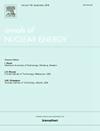Nuclear hydrogen demonstration project using the HTTR – Demarcation of nuclear-industrial laws and design standards
IF 1.9
3区 工程技术
Q1 NUCLEAR SCIENCE & TECHNOLOGY
引用次数: 0
Abstract
A high temperature gas cooled reactor has inherent safety features and potential to produce competitive and large amounts of carbon-free hydrogen. Japan Atomic Energy Agency has initiated the high temperature engineering test reactor (HTTR) Heat Application Test Project to establish coupling technologies for a nuclear hydrogen production system that connects a nuclear reactor plant and a hydrogen production plant. In order to ensure the public safety, appropriate laws and design standards should be applied to the hydrogen production plant because it handles combustible and toxic gases. The present study proposed a relative evaluation methodology using six metrics to characterize the superiority of candidates for the demarcation of applicable laws and design standards for a for the nuclear hydrogen production system. The proposed methodology was applied to the HTTR Heat Application Test Facility to select the most superior demarcation of applicable laws and design standards from six candidates for the HTTR Heat Application Test Facility. Candidates, applying nuclear law to all facilities, showed least superiority due to the higher cost of commercialized hydrogen production and the difficulty in entry for non-nuclear vendors to the business. The candidates, applying the High Pressure Gas Safety Act for the steam reformer and the Heat Application Test Facility (hydrogen production plant), showed least superiority in the feasibility of the system or the demonstration of the key equipment and technologies for commercialization depending on the installation of the secondary intermediate heat exchanger. On the other hand, a candidate applying the High Pressure Gas Safety Act to the Heat Application Test Facility (hydrogen production plant) and design standards established under the High Pressure Gas Safety Act to the steam reformer did not show the lowest category in any of the metrics, and was proposed as the most superior candidate for the demarcation of applicable laws and design standards the HTTR Heat Application Test Facility.
核氢示范工程采用HTTR -划定核工业法律和设计标准
高温气冷反应堆具有固有的安全特性和生产具有竞争力的大量无碳氢的潜力。日本原子能机构为建立连接核反应堆工厂和制氢工厂的核制氢系统的耦合技术,启动了“高温工程试验反应堆(HTTR)热应用试验项目”。为了确保公共安全,氢气生产工厂应适用适当的法律和设计标准,因为它处理可燃和有毒气体。本研究提出了一种相对的评价方法,使用六个指标来表征核制氢系统的适用法律和设计标准的划分候选的优越性。提出的方法应用于HTTR热应用测试设施,从六个候选的HTTR热应用测试设施中选择最优的适用法律和设计标准。将核法适用于所有设施的候选企业,由于商业化制氢的成本较高,而且非核企业进入该行业的难度较大,因此表现出的优势最小。对蒸汽转化炉和热应用试验设施(制氢厂)适用《高压气体安全法》的候选国,以安装二次中间换热器为基础,在系统的可行性或商业化的关键设备和技术的示范性方面表现出最低的优势。另一方面,将高压气体安全法应用于热应用试验设施(制氢厂)和根据高压气体安全法建立的设计标准应用于蒸汽转化炉的候选项目在任何指标中都没有显示出最低的类别,并且被提议为适用法律和设计标准划分的最优候选项目。
本文章由计算机程序翻译,如有差异,请以英文原文为准。
求助全文
约1分钟内获得全文
求助全文
来源期刊

Annals of Nuclear Energy
工程技术-核科学技术
CiteScore
4.30
自引率
21.10%
发文量
632
审稿时长
7.3 months
期刊介绍:
Annals of Nuclear Energy provides an international medium for the communication of original research, ideas and developments in all areas of the field of nuclear energy science and technology. Its scope embraces nuclear fuel reserves, fuel cycles and cost, materials, processing, system and component technology (fission only), design and optimization, direct conversion of nuclear energy sources, environmental control, reactor physics, heat transfer and fluid dynamics, structural analysis, fuel management, future developments, nuclear fuel and safety, nuclear aerosol, neutron physics, computer technology (both software and hardware), risk assessment, radioactive waste disposal and reactor thermal hydraulics. Papers submitted to Annals need to demonstrate a clear link to nuclear power generation/nuclear engineering. Papers which deal with pure nuclear physics, pure health physics, imaging, or attenuation and shielding properties of concretes and various geological materials are not within the scope of the journal. Also, papers that deal with policy or economics are not within the scope of the journal.
 求助内容:
求助内容: 应助结果提醒方式:
应助结果提醒方式:


